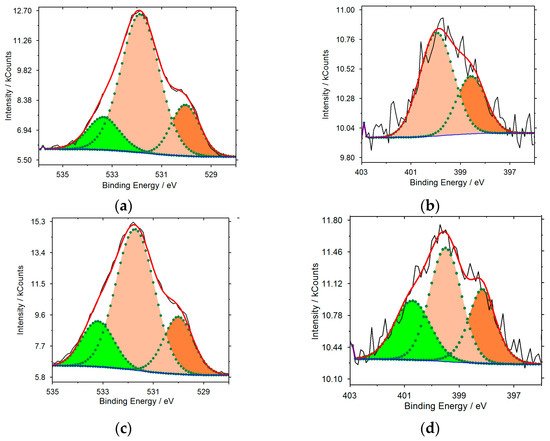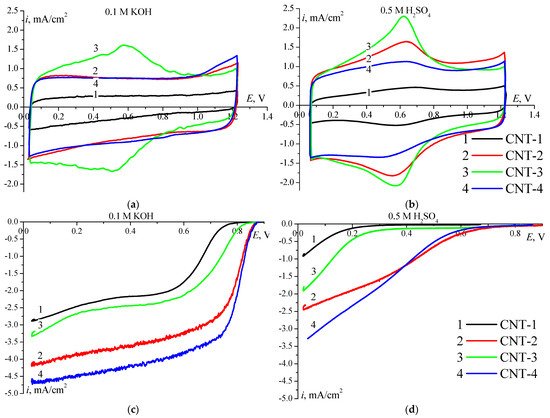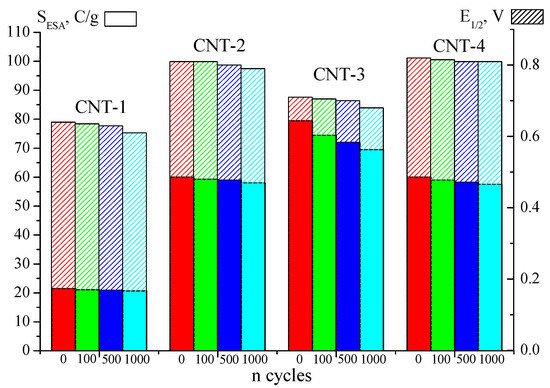2. Modified Carbon Nanotubes for Oxygen Reduction Reaction
The surface of the initial CNT is chemically inert
[22][23]; therefore, to activate it, functionalisation and/or doping are necessary to form active centres. Functionalisation of CNT with alkali yields a small number of oxygen-containing hydroxyl functional groups (532.3–532.8 eV) on the surface, as shown in
Table 1.
Table 1. Structural characteristics of surface and pH of studied CNT.
| No. |
Catalyst Treatment
Conditions |
Element/at.% |
SBET, m2/g |
Sspec., m2/g
C8H18//H2O |
ζ-Potential
in H2O |
pH in Water
from 6.5 in 30 min |
| 1 |
CNTNaOH |
O/2.18 |
297 |
333.5//49.2 |
−1.47 |
8.2 |
| 2 |
CNTNaOH-N |
O/10.08
N/1.15 |
269 |
268.8//154.2 |
−14.3 |
9.5 |
| 3 |
CNTHNO3 |
О/15.4
N/1.14 |
300 |
342.6//145.6 |
−41 |
5.7 |
| 4 |
CNTHNO3-N |
O/12.84
N/1.98 |
309 |
241.8//196 |
−23.9 |
7.7 |
Upon treating with nitric acid, several types of functional groups are formed on the surface: ketone/carbonyl (531.0–531.9 eV), hydroxyl and carboxyl (532.3–532.8 eV) (Table 1). Furthermore, the total oxygen content on the surface increases from 2.18 at.% for CNT-1 to 15.43 at.% for CNT-3. Moreover, after treatment with nitric acid, the surface of CNT-3 contains 1.14 at.% of nitrogen, mainly in the pyrrole form (399.7–400.6 eV) (Table 1). As a result of nitrogen doping, mainly pyrrole (0.77 at.%) and pyridine (398.1–398.6 eV, 0.38 at.%) nitrogen forms occur on the CNT-2 surface (Figure 1). On the surface of CNT-4, 0.91 at.% pyrrole nitrogen and 0.54 at.% graphitized N (400.7 eV) are present. Figure 1 shows the surface composition of modified nanotubes analysed by X-ray photoelectron spectroscopy (XPS).
Figure 1. O1s (a,c) and N1s (b,d) X-ray spectra recorded on CNT-2 (a,b) and on CNT-4 (c,d).
For CNT-1 and CNT-3, the surface values determined by the BET and MSP using octane are similar are close. It should be noted that the hydrophilic surface is significantly larger in nanotubes treated with nitric acid. One possible reason is the large number of different oxygen-containing groups in CNT-3. For in CNT-1, there are only OH
− on the surface; while in CNT-3, there are mainly carboxyl groups, which cause an electron density shift similar to formation of pyridine nitrogen, its consistent with
[7][8].
Possibly, this is due to the fact that carboxyl groups are the most active in ORR in alkaline media
[24]. One can assume that a significant number of carboxyl groups on the surface, where hydrogen has a charge of +0.2 and carbon of +0.4
[7][8], leads to the adsorption of hydroxide ions. In this case, the pH of the CNT-3 solution shifts slightly towards lower values (
Table 1). On the contrary, on the surface of CNT-1, there are only weakly bound groups OH
− that can be desorbed and shift the pH of water towards higher values, as seen in the experiment. Accordingly, the zeta potential tends to zero. CNT-3 has the highest zeta potential value among the studied samples; this is associated with the adsorption of hydroxide ions from water. In alkaline solutions containing a large quantity of OH
− ions, their adsorption on the negatively charged surface of carbon material is hindered; hence, oxygen is adsorbed and reduced on the electrode. This agrees with the fact that during desorption of hydroxide ions from the surface into the water, the zeta potential decreases (tends to zero in the case of CNT-1), and during the adsorption of OH
− it increases (CNT-3). As a result of the modification, the electron density and electron-donor properties increase on CNT-3.
The change in the hydrophobic–hydrophilic properties is associated with CNT functionalisation and doping and is characterised by the amount of oxygen- and nitrogen-containing groups (
Table 1). For CNT functionalised with alkali and acid, surface composition differs significantly. CNT-1 is characterised by the lowest hydrophilic surface area, compared with other samples, that comprises <15% of S
sp measured by octane. CNT doped with nitrogen have the largest hydrophilic surface and the higher content of N atoms on the surface, the larger hydrophilic surface area (81% of S
sp for CNT-4).
Figure 2 shows the pore volume as a function of the logarithm of their radius when measured using octane and water. For all studied CNT, the water curve is shifted towards larger radii than the octane curve. This indicates a weaker wettability with water than with octane
[25]; i.e., the average value of a wetting angle between water and all CNT samples exceeds zero. Measured in water and compared in the micro and mesopore region, the curves show that doping with N atoms results in an increase in the volume of hydrophilic pores with a radius of over 100 nm (
Figure 2, Curves 2 and 4). Obtained for octane, the pore volume of these nanotubes, as well as the surface composition, is similar. This indicates that introducing N into the CNT structure leads to a decrease in the pore volume (regardless of the functionalisation type) and an increase in the proportion of hydrophilic pores. The functionalisation affects hydrophilicity only in the case of pores with a larger radius (
Figure 2, Curves 1, 3 and 1′, 3′).
Figure 2. Integral curves of specific pore volume distribution V with respect to effective radii R (porometric curves) obtained with water (1, 2, 3, 4) and octane (1′, 2′, 3′, 4′) for CNT-1(1, 1′), CNT-2(2, 2′), CNT-3(3, 3′), and CNT-4 (4, 4′). The insert in the figure corresponds to the porometric curves in the area of micropores.
According to the data in Table 1 and Figure 2, the growth of oxygen-containing groups (mainly carboxyl) results in increase of the zeta potential and hydrophilic surface area. Upon subsequent nitrogen doping of functionalised CNT, the total pore volume measured with octane decreases, as well as the fraction of the volume of hydrophilic pores. For CNT-2 and CNT-4 the volume of hydrophilic pores is 1.2 cm3/g, while the maximum volume of hydrophilic pores is 2.5 cm3/g (CNT-3). The electrochemically active surface of CNT-3 is significantly higher than that of CNT-1 due to the large volume of hydrophilic pores (as will be shown further).
Electrical conductivity is one of the most important characteristics of electrode materials. The electrical conductivity of modified CNT is presented in Table 2.
Table 2. Electrical conductivity and electrochemical characteristics of modified CNT.
| No. |
Catalyst
Treatment Conditions |
1/2Q,
C/g |
Е1/2, V
½ilim.theoretical |
ikin, mA/cm2
//E, V
(+0.05 V from Estat) |
n, Number of Electrons |
i, mA/cm2
(at 0.2 V) |
κspec, S/cm |
ρ, g/cm3 * |
| in 0.1М KOH |
in 0.5М H2SO4 |
| 1 |
CNTNaOH |
21.5 |
0.64 |
0.12//0.75 |
1.6 |
0.124 |
0.234 |
0.407 |
| 2 |
CNTNaOH-N |
61.2 |
0.81 |
0.7//0.83 |
2.6 |
1.895 |
0.283 |
0.90 |
| 3 |
CNTHNO3 |
79.5 |
0.71 |
0.15//0.81 |
1.8 |
0.450 |
0.17 |
0.58 |
| 4 |
CNTHNO3-N |
62.0 |
0.82 |
0.9//0.83 |
3 |
2.329 |
0.212 |
0.85 |
CNT doped with nitrogen have the highest electrical conductivity. The high electrical conductivity for CNT-1 can be explained by lower (almost twice) material density than that of other CNT. Since the resistance was measured at a constant height between the electrodes (0.01 cm), the compaction of CNT with lower density is more prominent than that of CNT with high density. This leads to a higher number of contacts between neighbouring nanotubes and, consequently, increasing electrical conductivity. In the case of CNT-3, the low electrical conductivity (Table 2) is probably associated with the surface defects formed during harsh oxidation and lower compaction than that of CNT-1. For CNT-2 and CNT-4, the electrical conductivity amounts to 0.283 and 0.212 S/cm, respectively.
The Figure 3a,b shows CV of the studied CNT. The values of SEAS are given in Table 2. The electrochemical activity of modified CNT in ORR was investigated using 0.1 M KOH and 0.5 M H2SO4 electrolytes (Figure 3c,d). According to the polarisation curves the studied CNT exhibit high catalytic activity in an alkaline electrolyte.
Figure 3. CV on modified CNT in 0.1 M KOH (a) and in 0.5 M H2SO4 (b) electrolyte solution. Ar-saturated, 100 mV/s, 0.150 mg/cm2. Polarization curves of О2 reduction on modified CNTs in 0.1 M KOH (c) and in 0.5 M H2SO4 (d) electrolyte solution, 5 mV/s, 1500 rpm, 0.150 mg/cm2.
The shape of the obtained curves suggests the reaction mechanism. In the acidic electrolyte, functionalised CNT-1 and CNT-3 are not active in ORR since the entire surface of negatively charged carbon material is filled with hydrogen adsorbed from the solution. The activity of nitrogen-doped CNT in ORR is slightly higher. The presence of nitrogen leads to a decrease in the volume and surface of pores, moreover significant part of which is hydrophobic and provide oxygen supply to the active centres. The polarisation capacity of this type of CNT is higher than that of CNT-1 (
Figure 3). Due to the high electrical conductivity of CNT-2 and CNT-4, the activity in ORR in 0.5 M H
2SO
4 is higher than that on CNT-1 and CNT-3. In addition, the polarisation curve is positively shifted by ~0.300 V. The most probable factors influencing the activity are the low S
EAS value of CNT-1 and the actual electrical conductivity; CNT-3 shows the lowest electrical conductivity among the studied samples. The overall reason for the low activity of CNT in an acidic electrolyte comprises blocking the surface for oxygen adsorption by adsorbed hydrogen. Modified CNT, primarily doped with nitrogen, exhibit high activity in an alkaline electrolyte. A high negative value of the zeta potential and a shift in pH towards lower values (
Table 1) can be explained by the adsorption of OH
− ions on the surface and are observed only for CNT-3. In this regard, the high activity of CNT-3 in the ORR stems from the higher S
EAS value than that of CNT-1 (
Figure 3). In an alkaline electrolyte, the entire S
EAS remain accessible. OH
− ions do not adsorb on a negatively charged surface and do not hinder the oxygen adsorption and subsequent reduction. Thus, CNT modified with oxygen- and nitrogen-containing groups are ORR catalysts in an alkaline medium. In an alkaline electrolyte, CNT-1 is characterised by the lowest catalytic activity in the ORR due to the low content of heteroatoms on the surface and a small hydrophilic surface area. An increase in the activity of CNT-3 with respect to CNT-1 is associated with an increase in the number of oxygen-containing groups on its surface and the presence of nitrogen-containing groups increasing the hydrophilic and electrochemically active surface area (
Table 2), as well as a high negative value of surface zeta-potential. The nitrogen-doped CNT are characterised by the highest activity in ORR, due to the presence in the surface composition of carboxyl groups, as well as pyridine and pyrrole nitrogen groups, ensuring a large hydrophilic surface area. The half-wave potential values are 0.81V and 0.82V for CNT-2 and CNT-4, respectively, being close to the E
1/2 values for Pt-catalysts
[26]. In the case of CNT doped with nitrogen atoms, the current increases in the kinetic potential range, namely, 0.7 and 0.9 mA/cm
2 at 0.83 V for CNT-2 and CNT-4, respectively (
Table 2).
The corrosion stability of modified CNT was evaluated following the change in the SEAS value and the half-wave potential using the method of accelerated corrosion testing. All the studied materials are characterised by high stability within up to 1000 cycles (Figure 4). The maximum decrease in SEAS is observed at CNT-3 (13%) and may occur due to a large number of surface defects formed during the harsh oxidation with HNO3. However, more surface defects promote the incorporation of more N atoms (Table 1), which significantly increase the CNT-4 stability. Thus, functionalising CNT with nitric acid increases its hydrophilic and electrochemically active surface area due to the formation of surface defects during harsh oxidation; however, its stability decreases compared to that of CNT-1.
Figure 4. Variation of the SEAS and Е1/2 parameters of modified CNTs during accelerated corrosion testing in 0.1M KOH.




